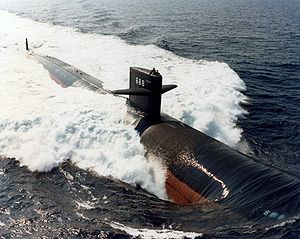 Los Angeles-class SSN profile
| |
 USS Los Angeles, lead boat of the class.
| |
| Class overview | |
|---|---|
| Builders | |
| Operators | |
| Preceded by | Sturgeon class |
| Succeeded by | Seawolf class |
| Cost | $900 million, 1990 dollars;[1] $1.86 billion, 2023 dollars[2] |
| Built | 1972–1996 |
| In commission | 1976–present |
| Completed | 62 |
| Active | 24 |
| Retired | 36 |
| Preserved | 2 (as moored training ships) |
| General characteristics | |
| Type | Nuclear attack submarine |
| Displacement | |
| Length | 362 ft (110 m) |
| Beam | 33 ft (10 m) |
| Draft | 31 ft (9.4 m) |
| Propulsion |
|
| Speed | |
| Range | Refueling required after 30 years[1] |
| Endurance | 90 days |
| Test depth | 450 m (1,480 ft)[4] |
| Complement | 129 |
| Sensors and processing systems | BQQ-5 suite which includes active and passive systems sonar, BQS-15 detecting and ranging sonar, WLR-8V(2) ESM receiver, WLR-9 acoustic receiver for detection of active search sonar and acoustic homing torpedoes, BRD-7 radio direction finder,[6] BPS-15 radar |
| Electronic warfare & decoys | WLR-10 countermeasures set[6] |
| Armament | 4 × 21 in (533 mm) torpedo tubes, 37 × Mk 48 torpedo, Tomahawk land attack missile, Harpoon anti-ship missile, Mk 67 mobile, or Mk 60 CAPTOR mines (FLTII and 688i FLTIII have a 12-tube VLS) |
The Los Angeles class of submarines are nuclear-powered fast attack submarines (SSN) in service with the United States Navy. Also known as the 688 class (pronounced "six-eighty-eight") after the hull number of lead vessel USS Los Angeles (SSN-688), 62 were built from 1972 to 1996, the latter 23 to an improved 688i standard. As of 2024, 24 of the Los Angeles class remain in commission—more than any other class in the world—and they account for almost half of the U.S. Navy's 50 fast attack submarines.[7]
Submarines of this class are named after American towns and cities, such as Albany, New York; Los Angeles, California; and Tucson, Arizona, with the exception of USS Hyman G. Rickover, named for the "father of the nuclear Navy." This was a change from traditionally naming attack submarines after marine animals, such as USS Seawolf or USS Shark. Rickover explained the decision to name the submarines after cities (and occasionally politicians influential in defense issues) by observing that "fish don't vote."[8]
- ^ a b SSN-688 Los Angeles class Archived 13 August 2014 at the Wayback Machine from Federation of American Scientists retrieved 29 February 2008 :The 18 SSN-688 class submarines that will be refueled in their midlives could make good candidates for a service life extension because they could operate for nearly 30 years after the refueling. After these submarines serve for 30 years, they could undergo a two-year overhaul and serve for one more 10-year operating cycle, for a total service life of 42 years.
- ^ Johnston, Louis; Williamson, Samuel H. (2023). "What Was the U.S. GDP Then?". MeasuringWorth. Retrieved 30 November 2023. United States Gross Domestic Product deflator figures follow the MeasuringWorth series.
- ^
"Attack Submarines - SSN". United States Navy. Retrieved 12 March 2023.
General Characteristics, Los Angeles class [...] Speed: 25+ knots (28+ miles per hour, 46.3 +kph)
- ^ a b Cite error: The named reference
Polmarwas invoked but never defined (see the help page). - ^
"Officials: U.S. submarine hit undersea mountain". CNN. 11 January 2005. Archived from the original on 18 October 2009. Retrieved 20 April 2008.
The submarine was traveling in excess of 33 knots—about 35 mph—when its nose hit the undersea formation head-on, officials said.
- ^ a b Polmar, Norman "The U. S. Navy Electronic Warfare (Part 1)" United States Naval Institute Proceedings October 1979 p.137
- ^ "Submarine Force Facts". Archived from the original on 8 June 2020. Retrieved 29 July 2020.
- ^ Clarity, James F.; Weaver, Warren Jr. (22 April 1985). "Briefing; Navy Reverts to Fish". The New York Times. ISSN 0362-4331. Retrieved 2 June 2022.